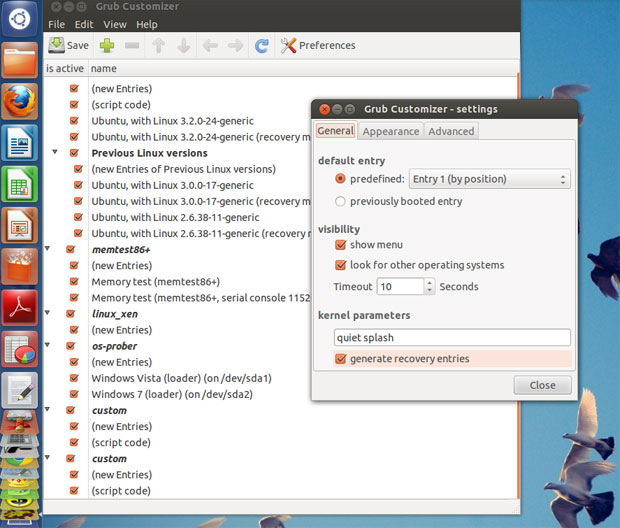
![]()
Few things scare me more than disk partitioning and GRUB configuration software. Both of those chores involve knowledge about hard drive operations and a good slice of luck. And both can render a computer unbootable with one slight user error. So discovering the latest version of Grub Customizer helped lower my anxiety levels considerably.

I write about computer hardware and software issues for a living. That involves a hefty portion of hands-on tinkering with my own and with colleagues’ computers. So working my way through uh-oh incidents is an occupational hazard.
For instance, I recently had a series of difficulties in converting some sluggish slightly older Windows boxes to Linux powerhouses. And some recent Windows software updates on several of my dual-boot test machines were stricken with the infamous why-did-that-happen? snafus. The GRUB configuration became trashed on system restarts.
These occurrences blocked access to booting into either the Windows OS or a specific Linux distro. Without the Grand Unified Bootloader, aka “GRUB,” intact, it did not matter that the partitions holding those installations were still living on the hard drive. So I looked for updates to my arsenal of GRUB-fixing tools.
Prevention Trumps Cure
Having more than one solution at hand often makes the difference between success and failure. That is particularly true when trying to resolve computer glitches. I initially found an app that seemed to have a good deal of potential for my software toolkit.
I planned initially to chronicle my experiences with StartUp-Manager, a graphical tool to manage settings for Grub (Grub Legacy), Grub 2, Usplash and Splashy. That app is still available through package management repositories but does not work well. It provides a menu-driven interface to set boot menu options such as the default operating system, menu timeouts and displays, password protection and much more.
But the developer of Startup-Manager gave up that project more than one year ago. He abandoned further updating after changes in several Linux distros and the conversion to GRUB 2 posed problems with the reliability of Startup-Manager. At least that is what the developer explained on his website.
I followed that developer’s recommendation and tried Grub Customizer. It was a great suggestion.
What It Does
Grub Customizer 2.5.5, the latest release, has an improved KDE menu compatibility. But fear not. This app works fine in other Linux desktop options.
Even better, it lets you create or remove submenus. This is handy. Previous versions only let you rename submenus or hide them.
This latest version also makes using live CDs of Linux distros easier to manipulate. I found it very handy for “adjusting” the GRUB screen on computers holding numerous Linux distros along with several Windows OS versions.
Grub Customizer’s graphical interface is easy to use. It makes configuring the grub2/burg settings a lot less daunting. Its focus is on preserving the individual list order without losing GRUB’s dynamic behavior.
Tandem Tool
I previously reviewed Super GRUB 2 disk and Rescatux disk as very useful tools when I needed to jumpstart one of my computers. What Super GRUB 2 Disk could not accomplish, Rescatux was able to achieve.
These two apps succeeded in fixing the broken GRUB process and creating (or retrieving) the failed deleted partition. Grub Customizer does not infringe on that rescue ability. You can also use it with a live distro CD to repair a bad GRUB file.
But It serves a different purpose. Grub Customizer’s main feature is the boot entry list configuration. It goes beyond just modifying the grub.cfg file. It lets you do the task easily while keeping the configuration and while tweaking its appearance.
Getting It
Grub Customizer is not yet offered in package management systems. So getting it involves entering a few lines of manual instruction in a terminal window. The process is semi-automated.
This apporach works flawlessly with the latest releases of Ubuntu and Linux Mint. If it fails on other distros — check with those forums for how to modify the commands as needed.
sudo apt-add-repository ppa:danielrichter2007/grub-customizer
sudo apt-get update
sudo apt-get install grub-customizer
Intuitive Interface
I love apps that you can use without learning its intricacies. Grub Customizer hits that mark. Its menu system is simple but functional. It gives you five main options: File, Edit, View and Help.
Like most Linux software, the Help option is mostly useless and only provides typical About-the-App details. This is not an app for use by anyone unfamiliar with the bootloading process. Some documentation is available online. But the developer, Daniel Richter, should at least provide links to them in the Help menu so users do not have to hunt for usage tips and more detailed documentation.
The File option offers Select the Partition, Save, Install to MBR (Master Boot Record) and Quit. Edit contains basic navigational options for the displayed GRUB screen. It also has access to the Preferences panel. View lets you refresh the Grub display. You can also do this with the F5 key.
Most of these options are also available from the tool bar row below the menus. The rest of the interface shows the items in the GRUB file with check boxes to activate or disable each item.
Preferred Preferences
The Grub Customizer Settings panel offers three tabs. The General tab sets you choice to display predefined entries from a scrollable list or previously booted entries.
You also to choose to see the menu and look for other operating systems with a timeout selection. One item you should make sure is checked is the option to generate recovery entries.
The appearance tab lets you set custom resolutions, menu colors and background images. The Advanced tab lets you Add/Remove checked display items for the Grub menu.
Bottom Line
Grub Customizer is a useful app for modifying and fixing the GRUB2 settings. It also provides a simple way to be prepared to fix or recover from GRUB configuration file problems before disaster strikes.
Much of what this app does is not that easy to accomplish through conventional methods. The graphical interface really simplifies the process of moving GRUB screen entries, renaming them or disabling entries.




















































